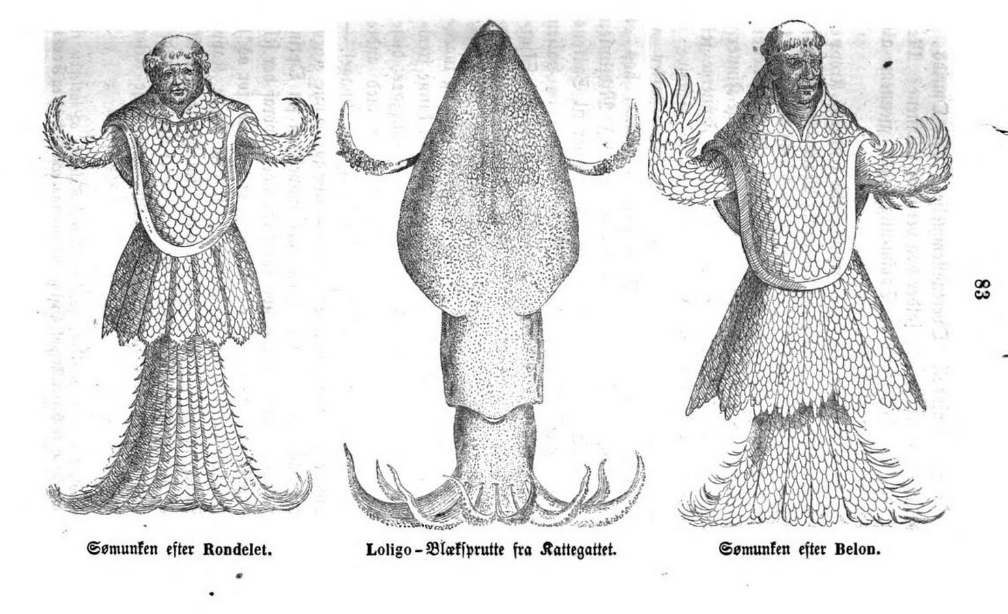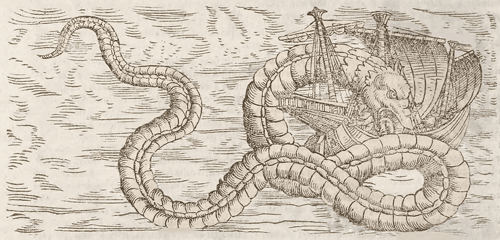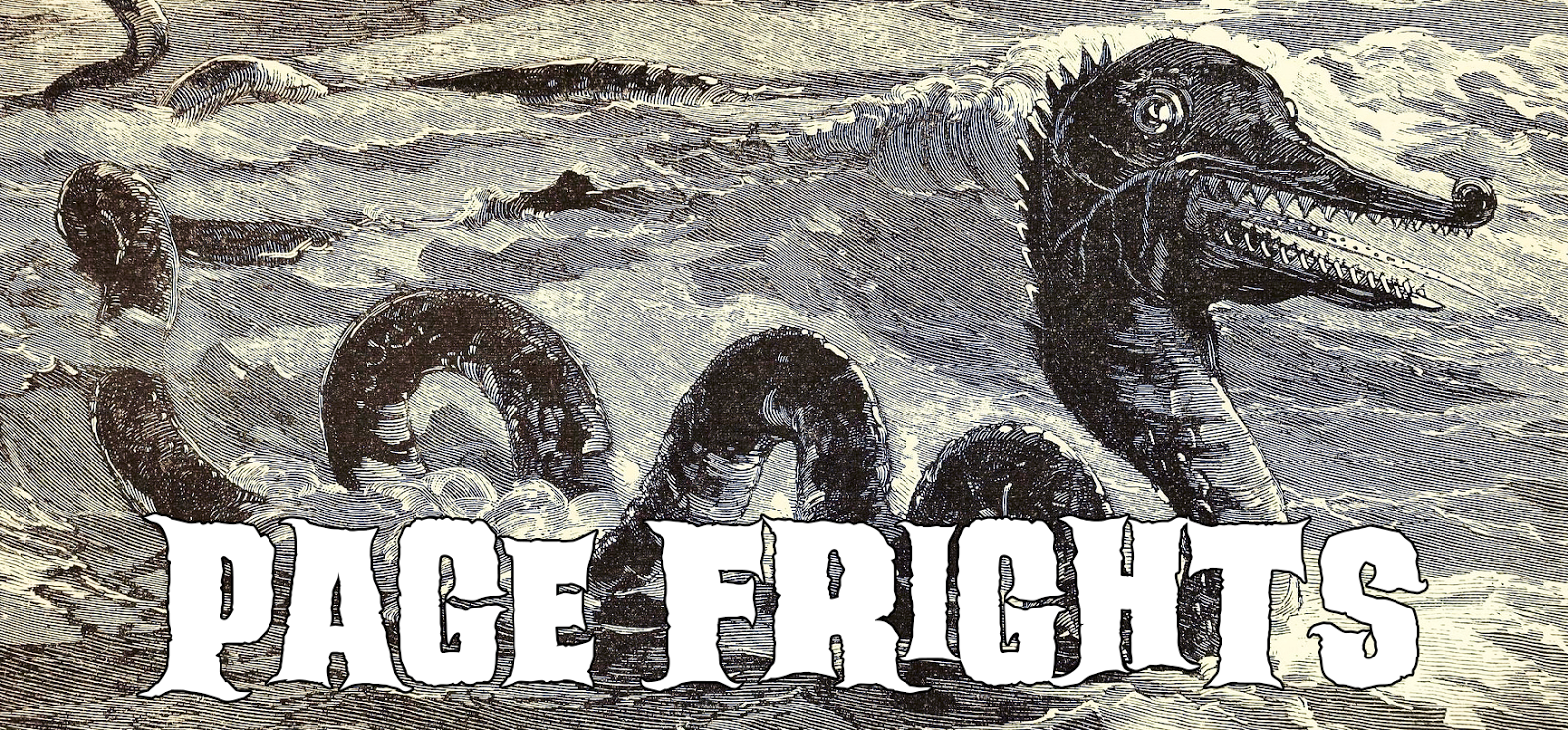Sea Monks and Other Page Frights: Celebrate Halloween, Library and Archives Style!
Welcome to Page Frights, a month-long social media celebration of Halloween!
All this month (1-31 October), libraries and archives around the world will be sharing spooky, creepy, frightening, and otherwise Halloween-related books and images from their collections on social media with the hashtag #PageFrights.
Follow along and join the conversation on Twitter, Instagram, Facebook, Tumblr, and other social media sites and visit the Page Frights website to learn more.
We have lots of great content planned for BHL this month as part of Page Frights. Would you like a taste of what you can expect? If so, please allow us to introduce the sea monk!
Piscis monachi habitu, “Fish with the habit of a monk”
In the 1540s (probably in 1546), a mysterious creature was caught in the Øresund, the strait between the island of Sjælland (Denmark) and Sweden. The creature was described as a sea monk (or monk fish) with “a human head and face, resembling in appearance the men with shorn heads, whom we call monks because of their solitary life; but the appearance of its lower parts, bearing a coating of scales, barely indicated the torn and severed limbs and joints of the human body” (Paxton & Holland, 39).
 |
| The monk fish, pisces monachus. Belon, Pierre. De Aquatilibus. 1553. http://biodiversitylibrary.org/page/4770183. Digitized by the Ernst Mayr Library, Museum of Comparative Zoology, Harvard University. |
The discovery was described by several naturalists of the day, including Pierre Belon (who described it as the monk fish, pisces monachus, in his 1553 publication De Aquatilibus), Guillaume Rondelet (who described it as piscis monachi habitu, “fish with the habit of a monk”, in his 1554 publication Libri de Piscibus Marinis), and Conrad Gesner (who summarized Rondelet and Belon’s accounts and referenced additional drawings by Georg Fabricius and a Hector Mythobius in his 1558 Historia Animalium). None of these men had actually seen the specimen that they described, and Belon and Rondelet’s accounts were obtained from as yet unidentified German source material (Paxton & Holland, 40, 46).
 |
| Piscis monachi habitu, “fish with the habit of a monk”. Rondelet, Guillaume. Libri de Piscibus Marinis. 1554. http://biodiversitylibrary.org/page/42089971. Digitized by Smithsonian Libraries. |
While these publications were clearly linked to a 16th century encounter with a mysterious zoological specimen, they are not the earliest known references to a sea monk. Sea monks were referenced as early as the late 12th or early 13th centuries, such as in Alexander Neckham’s De Naturis Rerum (which includes the statement “other fish resemble monks”) and in Albertus Magnus’ De Animalibus (which references Monachus maris, “the sea monk…a fish occasionally seen in the British sea…[which] entices those travelling on the sea until it lures them in. It then seeks to the bottom and takes its fill of their flesh”) (Paxton & Holland, 43).
What species could have been the inspiration for such a mysterious creature? Many theories have been proposed. Danish zoologist Japetus Steenstrup proposed in his 1855 publication ‘Om den i Kong Christian IIIs tid i Øresundet fanget Havmund (Sømunken kaldet)‘ that the Øresund specimen was a giant squid (Paxton & Holland, 42). Other suggestions include various seal species or even a walrus. More recently, it was suggested that the Øresund monkfish was actually an angelshark species, possibly Squatina squatina (Paxton & Holland, 43).
 |
| Comparison of Rondelet and Belon’s sea monks with a giant squid. Steenstrup, Japetus. Om den i Kong Christian IIIs tid i Øresundet fanget Havmund (Sømunken kaldet). Dansk Maanedsskrift. v. 1 (1855). Obtained via Google Books. |
Identifying an origin species for the monkfish is further complicated by the fact that these representations were also possibly influenced by religious tensions of the period. The association between clerical figures and monsters may be seen as a commentary on these tensions, with religious elements being imposed on natural entities.
Since the original Øresund specimen is lost, pisces monachus will likely forever remain shrouded in mystery – a frightening entry in the chronicles of natural history.
Celebrate Halloween, Library & Archives Style with Page Frights
We invite you to join us for Page Frights this month as we highlight other fascinating, frightening, and/or Halloween-related natural history images and publications. BHL content will include:
- Social media posts on Twitter, Facebook, and Instagram
- Blog posts
- Page Frights image collections in Flickr and Pinterest
- A collection of “monster” natural history books in our Monsters Are Real BHL collection
- Pumpking carving patterns inspired by BHL images in the Page Frights Pumpkin Pattern Gallery
Also as part of Page Frights, joining this year’s GIF IT UP fun by encouraging you to create creepy GIFs inspired by #PageFrights images. Learn more.
 |
| “Attack of the Sea Monster!” In 1555, Olaus Magnus published an image and description of the Soe Orm, which he claimed was a giant sea serpent 200 feet in length that lived near the shore or Bergen and came out at night to eat the farmers’ livestock. His image and description was republished for centuries. See more fantastic images come to life as part of GIF IT UP. GIF created by Richard Naples (Smithsonian Libraries), based on Gessner, Conrad. Historia Animalium. 2nd ed. 1604. http://biodiversitylibrary.org/page/42166517. |
Get Your Own Sea Monster & Support Biodiversity Research
With our Page Frights CafePress collection, you can purchase your very own piece of the Page Frights fun and help support scientific research at the same time! 100% of the proceeds from product sales will be used to digitize more books for BHL.
Learn more about how free and open access to natural history publications on BHL can help save biodiversity and transform research.
Reference
Paxton, C. G. M. & R. Holland. Was Steenstrup Right? A New Interpretation of the 16th Century Sea Monk of the Øresund. – Steenstrupia 29 (1): 39–47. Copenhagen, Denmark. November 2005. ISSN 0375-2909.







Leave a Comment